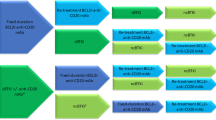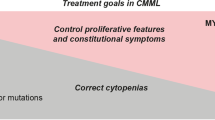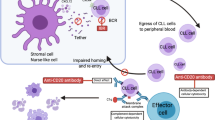Abstract
Recent advances in purine analog-based combination chemotherapy and chemoimmunotherapy have significantly improved response rates and progression-free survival in patients with B-cell chronic lymphocytic leukemia (CLL). However, there are clinical scenarios in which purine analog-based treatment may not be appropriate, either because of the risk of toxicity in patients with comorbidity or because purine analog-based therapies are unlikely to achieve satisfactory responses. Novel, nonchemotherapeutic treatment regimens are becoming increasingly important in these patients, as well as in patients in whom combination chemotherapy-based treatment has failed or resulted in relapse. Nonchemotherapeutic agents include monoclonal antibodies, glucocorticoids, immunomodulatory drugs, drugs with specific intracellular molecular targets, vaccines and cellular immunotherapies. These agents use diverse mechanisms of action that may complement each other, therefore providing a scientific rationale to investigate combinations of these agents in the treatment of CLL. In this review, we will discuss current knowledge of available nonchemotherapeutic agents, available clinical experience with their use alone and in combination and how these approaches may affect outcomes in patients with CLL.
This is a preview of subscription content, access via your institution
Access options
Subscribe to this journal
Receive 12 print issues and online access
$259.00 per year
only $21.58 per issue
Buy this article
- Purchase on Springer Link
- Instant access to full article PDF
Prices may be subject to local taxes which are calculated during checkout
Similar content being viewed by others
References
Jemal A, Siegel R, Ward E, Hao Y, Xu J, Murray T et al. Cancer statistics, 2008. CA Cancer J Clin 2008; 58: 71–96.
Byrd JC, Stilgenbauer S, Flinn IW . Chronic lymphocytic leukemia. Hematology Am Soc Hematol Educ Program 2004, 163–183.
Dohner H, Stilgenbauer S, Benner A, Leupolt E, Krober A, Bullinger L et al. Genomic aberrations and survival in chronic lymphocytic leukemia. N Engl J Med 2000; 343: 1910–1916.
Bosch F, Ferrer A, Villamor N, Gonzalez M, Briones J, Gonzalez-Barca E et al. Fludarabine, cyclophosphamide, and mitoxantrone as initial therapy of chronic lymphocytic leukemia: high response rate and disease eradication. Clin Cancer Res 2008; 14: 155–161.
Catovsky D, Richards S, Matutes E, Oscier D, Dyer MJ, Bezares RF et al. Assessment of fludarabine plus cyclophosphamide for patients with chronic lymphocytic leukaemia (the LRF CLL4 Trial): a randomised controlled trial. Lancet 2007; 370: 230–239.
Eichhorst BF, Busch R, Hopfinger G, Pasold R, Hensel M, Steinbrecher C et al. Fludarabine plus cyclophosphamide versus fludarabine alone in first-line therapy of younger patients with chronic lymphocytic leukemia. Blood 2006; 107: 885–891.
Flinn IW, Neuberg DS, Grever MR, Dewald GW, Bennett JM, Paietta EM et al. Phase III trial of fludarabine plus cyclophosphamide compared with fludarabine for patients with previously untreated chronic lymphocytic leukemia: US Intergroup Trial E2997. J Clin Oncol 2007; 25: 793–798.
Kay NE, Geyer SM, Call TG, Shanafelt TD, Zent CS, Jelinek DF et al. Combination chemoimmunotherapy with pentostatin, cyclophosphamide, and rituximab shows significant clinical activity with low accompanying toxicity in previously untreated B chronic lymphocytic leukemia. Blood 2007; 109: 405–411.
Rai KR, Peterson BL, Appelbaum FR, Kolitz J, Elias L, Shepherd L et al. Fludarabine compared with chlorambucil as primary therapy for chronic lymphocytic leukemia. N Engl J Med 2000; 343: 1750–1757.
Keating MJ, O’Brien S, Albitar M, Lerner S, Plunkett W, Giles F et al. Early results of a chemoimmunotherapy regimen of fludarabine, cyclophosphamide, and rituximab as initial therapy for chronic lymphocytic leukemia. J Clin Oncol 2005; 23: 4079–4088.
Robak T, Blonski JZ, Gora-Tybor J, Jamroziak K, Dwilewicz-Trojaczek J, Tomaszewska A et al. Cladribine alone and in combination with cyclophosphamide or cyclophosphamide plus mitoxantrone in the treatment of progressive chronic lymphocytic leukemia: report of a prospective, multicenter, randomized trial of the Polish Adult Leukemia Group (PALG CLL2). Blood 2006; 108: 473–479.
Bosch F, Muntanola A, Villamor N, Terol MJ, Gonzalez-Barca E, Ribera JM et al. Preliminary results of the combination rituximab, fludarabine, cyclophosphamide and mitoxantrone (R-FCM) followed by rituximab maintenance in previously untreated chronic lymphocytic leukemia (CLL). Blood 2007; 110: 193a.
Faderl S, Wierda W, Ferrajoli A, O’Brien S, Ravandi F, Kantarjian HM et al. Update of experience with fludarabine, cyclophosphamide, mitoxantrone plus rituximab (FCM-R) in frontline therapy for chronic lymphocytic leukemia (CLL). Blood 2007; 110: 193a–194a.
Keating MJ, Flinn I, Jain V, Binet JL, Hillmen P, Byrd J et al. Therapeutic role of alemtuzumab (Campath-1H) in patients who have failed fludarabine: results of a large international study. Blood 2002; 99: 3554–3561.
Hillmen P, Skotnicki AB, Robak T, Jaksic B, Dmoszynska A, Wu J et al. Alemtuzumab compared with chlorambucil as first-line therapy for chronic lymphocytic leukemia. J Clin Oncol 2007; 25: 5616–5623.
Huhn D, von SC, Wilhelm M, Ho AD, Hallek M, Kuse R et al. Rituximab therapy of patients with B-cell chronic lymphocytic leukemia. Blood 2001; 98: 1326–1331.
Hainsworth JD, Litchy S, Barton JH, Houston GA, Hermann RC, Bradof JE et al. Single-agent rituximab as first-line and maintenance treatment for patients with chronic lymphocytic leukemia or small lymphocytic lymphoma: a phase II trial of the Minnie Pearl Cancer Research Network. J Clin Oncol 2003; 21: 1746–1751.
Thornton PD, Hamblin M, Treleaven JG, Matutes E, Lakhani AK, Catovsky D . High dose methyl prednisolone in refractory chronic lymphocytic leukaemia. Leuk Lymphoma 1999; 34: 167–170.
Thornton PD, Matutes E, Bosanquet AG, Lakhani AK, Grech H, Ropner JE et al. High dose methylprednisolone can induce remissions in CLL patients with p53 abnormalities. Ann Hematol 2003; 82: 759–765.
Chanan-Khan A, Miller KC, Musial L, Lawrence D, Padmanabhan S, Takeshita K et al. Clinical efficacy of lenalidomide in patients with relapsed or refractory chronic lymphocytic leukemia: results of a phase II study. J Clin Oncol 2006; 24: 5343–5349.
Ferrajoli A, Lee BN, Schlette EJ, O’Brien SM, Gao H, Wen S et al. Lenalidomide induces complete and partial remissions in patients with relapsed and refractory chronic lymphocytic leukemia. Blood 2008; 111: 5291–5297.
Byrd JC, Lin TS, Dalton JT, Wu D, Phelps MA, Fischer B et al. Flavopiridol administered using a pharmacologically derived schedule is associated with marked clinical efficacy in refractory, genetically high-risk chronic lymphocytic leukemia. Blood 2007; 109: 399–404.
Ravandi F, O’Brien S . Alemtuzumab. Expert Rev Anticancer Ther 2005; 5: 39–51.
Lozanski G, Heerema NA, Flinn IW, Smith L, Harbison J, Webb J et al. Alemtuzumab is an effective therapy for chronic lymphocytic leukemia with p53 mutations and deletions. Blood 2004; 103: 3278–3281.
Osuji NC, Del Giudice I, Matutes E, Wotherspoon AC, Dearden C, Catovsky D . The efficacy of alemtuzumab for refractory chronic lymphocytic leukemia in relation to cytogenetic abnormalities of p53. Haematologica 2005; 90: 1435–1436.
Stilgenbauer S, Dohner H . Campath-1H-induced complete remission of chronic lymphocytic leukemia despite p53 gene mutation and resistance to chemotherapy. N Engl J Med 2002; 347: 452–453.
Stilgenbauer S, Winkler D, Buhler A, Zenz T, Groner S, Busch R et al. Subcutaneous alemtuzumab (MabCampath) in fludarabine-refractory CLL (CLL2H trial of the GCLLSG). Blood 2007; 110: 918a.
Maloney DG, Smith B, Rose A . Rituximab: mechanism of action and resistance. Semin Oncol 2002; 29: 2–9.
Reff ME, Carner K, Chambers KS, Chinn PC, Leonard JE, Raab R et al. Depletion of B cells in vivo by a chimeric mouse human monoclonal antibody to CD20. Blood 1994; 83: 435–445.
McLaughlin P, Grillo-Lopez AJ, Link BK, Levy R, Czuczman MS, Williams ME et al. Rituximab chimeric anti-CD20 monoclonal antibody therapy for relapsed indolent lymphoma: half of patients respond to a four-dose treatment program. J Clin Oncol 1998; 16: 2825–2833.
Byrd JC, Murphy T, Howard RS, Lucas MS, Goodrich A, Park K et al. Rituximab using a thrice weekly dosing schedule in B-cell chronic lymphocytic leukemia and small lymphocytic lymphoma demonstrates clinical activity and acceptable toxicity. J Clin Oncol 2001; 19: 2153–2164.
O’Brien SM, Kantarjian H, Thomas DA, Giles FJ, Freireich EJ, Cortes J et al. Rituximab dose-escalation trial in chronic lymphocytic leukemia. J Clin Oncol 2001; 19: 2165–2170.
Winkler U, Jensen M, Manzke O, Schulz H, Diehl V, Engert A . Cytokine-release syndrome in patients with B-cell chronic lymphocytic leukemia and high lymphocyte counts after treatment with an anti-CD20 monoclonal antibody (rituximab, IDEC-C2B8). Blood 1999; 94: 2217–2224.
Bello C, Sotomayor EM . Monoclonal antibodies for B-cell lymphomas: rituximab and beyond. Hematology Am Soc Hematol Educ Program 2007; 2007: 233–242.
Teeling JL, French RR, Cragg MS, van den BJ, Pluyter M, Huang H et al. Characterization of new human CD20 monoclonal antibodies with potent cytolytic activity against non-Hodgkin lymphomas. Blood 2004; 104: 1793–1800.
Coiffier B, Lepretre S, Pedersen LM, Gadeberg O, Fredriksen H, van Oers MH et al. Safety and efficacy of ofatumumab, a fully human monoclonal anti-CD20 antibody, in patients with relapsed or refractory B-cell chronic lymphocytic leukemia: a phase 1–2 study. Blood 2008; 111: 1094–1100.
Bonnefoy JY, Lecoanet-Henchoz S, Gauchat JF, Graber P, Aubry JP, Jeannin P et al. Structure and functions of CD23. Int Rev Immunol 1997; 16: 113–128.
Lopez-Matas M, Rodriguez-Justo M, Morilla R, Catovsky D, Matutes E . Quantitative expression of CD23 and its ligand CD21 in chronic lymphocytic leukemia. Haematologica 2000; 85: 1140–1145.
Pathan NI, Chu P, Hariharan K, Cheney C, Molina A, Byrd J . Mediation of apoptosis by and antitumor activity of lumiliximab in chronic lymphocytic leukemia cells and CD23+ lymphoma cell lines. Blood 2008; 111: 1594–1602.
Byrd JC, Castro J, O’Brien S, Flinn IW, Forero-Torres A, Kipps TJ et al. Comparison of results from a phase 1/2 study of lumiliximab (anti-CD23) in combination with FCR for patients with relapsed CLL with published FCR results. Blood 2006; 108: 14a.
Wierda W, O’Brien S, Wen S, Faderl S, Garcia-Manero G, Thomas D et al. Chemoimmunotherapy with fludarabine, cyclophosphamide, and rituximab for relapsed and refractory chronic lymphocytic leukemia. J Clin Oncol 2005; 23: 4070–4078.
Clarke AR, Purdie CA, Harrison DJ, Morris RG, Bird CC, Hooper ML et al. Thymocyte apoptosis induced by p53-dependent and independent pathways. Nature 1993; 362: 849–852.
Anderson KC . Lenalidomide and thalidomide: mechanisms of action—similarities and differences. Semin Hematol 2005; 42: S3–S8.
Ramsay AG, Johnson AJ, Lee AM, Gorgun G, Le DR, Blum W et al. Chronic lymphocytic leukemia T cells show impaired immunological synapse formation that can be reversed with an immunomodulating drug. J Clin Invest 2008; 118: 2427–2437.
Andritsos LA, Johnson AJ, Lozanski G, Blum W, Kefauver C, Awan F et al. Higher doses of lenalidomide are associated with unacceptable toxicity including life-threatening tumor flare in patients with chronic lymphocytic leukemia. J Clin Oncol 2008; 26: 2519–2525.
Mani A, Gelmann EP . The ubiquitin–proteasome pathway and its role in cancer. J Clin Oncol 2005; 23: 4776–4789.
Faderl S, Rai K, Gribben J, Byrd JC, Flinn IW, O’Brien S et al. Phase II study of single-agent bortezomib for the treatment of patients with fludarabine-refractory B-cell chronic lymphocytic leukemia. Cancer 2006; 107: 916–924.
Hanada M, Delia D, Aiello A, Stadtmauer E, Reed JC . Bcl-2 gene hypomethylation and high-level expression in B-cell chronic lymphocytic leukemia. Blood 1993; 82: 1820–1828.
Cimmino A, Calin GA, Fabbri M, Iorio MV, Ferracin M, Shimizu M et al. miR-15 and miR-16 induce apoptosis by targeting BCL2. Proc Natl Acad Sci USA 2005; 102: 13944–13949.
Robertson LE, Plunkett W, McConnell K, Keating MJ, McDonnell TJ . Bcl-2 expression in chronic lymphocytic leukemia and its correlation with the induction of apoptosis and clinical outcome. Leukemia 1996; 10: 456–459.
O’Brien S, Moore JO, Boyd TE, Larratt LM, Skotnicki A, Koziner B et al. Randomized phase III trial of fludarabine plus cyclophosphamide with or without oblimersen sodium (Bcl-2 antisense) in patients with relapsed or refractory chronic lymphocytic leukemia. J Clin Oncol 2007; 25: 1114–1120.
Dai Y, Grant S . Cyclin-dependent kinase inhibitors. Curr Opin Pharmacol 2003; 3: 362–370.
Chen R, Keating MJ, Gandhi V, Plunkett W . Transcription inhibition by flavopiridol: mechanism of chronic lymphocytic leukemia cell death. Blood 2005; 106: 2513–2519.
Hussain SR, Lucas DM, Johnson AJ, Lin TS, Bakaletz AP, Dang VX et al. Flavopiridol causes early mitochondrial damage in chronic lymphocytic leukemia cells with impaired oxygen consumption and mobilization of intracellular calcium. Blood 2008; 111: 3190–3199.
Flinn IW, Byrd JC, Bartlett N, Kipps T, Gribben J, Thomas D et al. Flavopiridol administered as a 24-h continuous infusion in chronic lymphocytic leukemia lacks clinical activity. Leuk Res 2005; 29: 1253–1257.
Byrd JC, Peterson BL, Gabrilove J, Odenike OM, Grever MR, Rai K et al. Treatment of relapsed chronic lymphocytic leukemia by 72-h continuous infusion or 1-h bolus infusion of flavopiridol: results from Cancer and Leukemia Group B study 19805. Clin Cancer Res 2005; 11: 4176–4181.
Kater AP, van Oers MH, Kipps TJ . Cellular immune therapy for chronic lymphocytic leukemia. Blood 2007; 110: 2811–2818.
Le DR, Gribben J . Vaccine- and immune-based therapy in chronic lymphocytic leukemia. Semin Oncol 2006; 33: 220–229.
Hus I, Rolinski J, Tabarkiewicz J, Wojas K, Bojarska-Junak A, Greiner J et al. Allogeneic dendritic cells pulsed with tumor lysates or apoptotic bodies as immunotherapy for patients with early-stage B-cell chronic lymphocytic leukemia. Leukemia 2005; 19: 1621–1627.
Kipps T, Castro JE, Wierda W, Keating MJ, Bole J, Meyer J et al. A phase I/II trial of Xcellerated T cells in patients with chronic lymphocytic leukemia (CLL) [abstract 370]. Blood 2003; 102: 109a.
Ashraf U, Elefante AN, Cruz R, Wallace PK, Czuczman MS, Hernandez-Ilizaliturri FJ . Emergence of rituximab–fludarabine resistance is associated with changes in CD20 antigen expression and improved response to alemtuzumab therapy in patients with chronic lymphocytic leukemia (CLL). Blood 2007; 110: 612a.
Harris SL, Levine AJ . The p53 pathway: positive and negative feedback loops. Oncogene 2005; 24: 2899–2908.
Faderl S, Thomas DA, O’Brien S, Garcia-Manero G, Kantarjian HM, Giles FJ et al. Experience with alemtuzumab plus rituximab in patients with relapsed and refractory lymphoid malignancies. Blood 2003; 101: 3413–3415.
Faderl S, Ferrajoli A, Wierda W, Ravandi F, O’Brien S, Garcia-Manero G et al. Continuous infusion/subcutaneous alemtuzumab (Campath-1H) plus rituximab is active for patients with relapsed/refractory chronic lymphocytic leukemia (CLL). Blood 2005; 106: 831a.
Nabhan C, Patton D, Gordon LI, Riley MB, Kuzel T, Tallman MS et al. A pilot trial of rituximab and alemtuzumab combination therapy in patients with relapsed and/or refractory chronic lymphocytic leukemia (CLL). Leuk Lymphoma 2004; 45: 2269–2273.
Zent CS, Call TG, Shanafelt TD, Jelinek DF, Tschumper RC, Secreto CR et al. Alemtuzumab and rituximab for initial treatment of high risk, early stage chronic lymphocytic leukemia (CLL) [abstract 2050]. Blood 2007; 110: 611a.
Frankfurt O, Hamilton E, Acharya S, Duffey S, Raji A, Rosen ST . A phase II trial of alemtuzumab and rituximab in patients with previously untreated CLL. Blood 2007; 110: 612a–613a.
Pettitt AR, Matutes E, Oscier D . Alemtuzumab in combination with high-dose methylprednisolone is a logical, feasible and highly active therapeutic regimen in chronic lymphocytic leukaemia patients with p53 defects. Leukemia 2006; 20: 1441–1445.
Bowen DA, Call TG, Jenkins GD, Zent CS, Schwager SM, Van Dyke DL et al. Methylprednisolone–rituximab is an effective salvage therapy for patients with relapsed chronic lymphocytic leukemia including those with unfavorable cytogenetic features. Leuk Lymphoma 2007; 48: 2412–2417.
Dungarwalla M, Evans SO, Riley U, Catovsky D, Dearden CE, Matutes E . High dose methylprednisolone and rituximab is an effective therapy in advanced refractory chronic lymphocytic leukemia resistant to fludarabine therapy. Haematologica 2008; 93: 475–476.
Acknowledgements
We thank Wei Jiang, PhD, for assistance in preparing and editing this manuscript.
Author information
Authors and Affiliations
Corresponding author
Rights and permissions
About this article
Cite this article
Faderl, S., Ferrajoli, A., Frankfurt, O. et al. Treatment of B-cell chronic lymphocytic leukemia with nonchemotherapeutic agents: experience with single-agent and combination therapy. Leukemia 23, 457–466 (2009). https://doi.org/10.1038/leu.2008.322
Received:
Accepted:
Published:
Issue Date:
DOI: https://doi.org/10.1038/leu.2008.322



